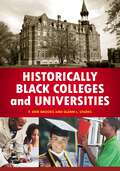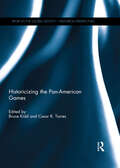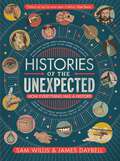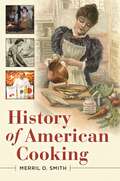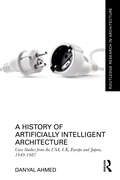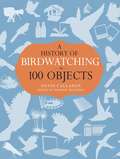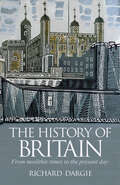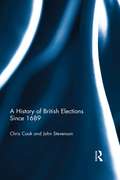- Table View
- List View
Historical Parallels, Commemoration and Icons (Routledge Approaches to History)
by Andreas LeutzschHistorical parallels, analogies, anachronisms and metaphors to the past play a crucial role in political speeches, historical narratives, iconography, movies and newspapers on a daily basis. They frame, articulate and represent a specific understanding of history and can be used not only to construct but also to rethink historical continuity. Almost-forgotten or sleeping history can be revived to legitimize an imagined future in a political discourse today. History can hardly be neutral or factual because it depends on the historian’s, as well the people’s, perspective as to what kind of events and sources they combine to make history meaningful. Analysing historical analogies – as embedded in narratives and images of the past – enables us to understand how history and collective memory are managed and used for political purposes and to provide social orientation in time and space. To rethink theories of history, iconology and collective memory, the authors of this volume discuss a variety of cases from Hong Kong, China and Europe.
Historical Parallels, Commemoration and Icons (Routledge Approaches to History)
by Andreas LeutzschHistorical parallels, analogies, anachronisms and metaphors to the past play a crucial role in political speeches, historical narratives, iconography, movies and newspapers on a daily basis. They frame, articulate and represent a specific understanding of history and can be used not only to construct but also to rethink historical continuity. Almost-forgotten or sleeping history can be revived to legitimize an imagined future in a political discourse today. History can hardly be neutral or factual because it depends on the historian’s, as well the people’s, perspective as to what kind of events and sources they combine to make history meaningful. Analysing historical analogies – as embedded in narratives and images of the past – enables us to understand how history and collective memory are managed and used for political purposes and to provide social orientation in time and space. To rethink theories of history, iconology and collective memory, the authors of this volume discuss a variety of cases from Hong Kong, China and Europe.
An Historical Sketch of Bookbinding
by Sarah T. PrideauxAn Historical Sketch Of Bookbinding is a part of ‘The History of Bookbinding Technique and Design’-A series of reprint volumes, original monographs, and translations relating to the history of bookbinding. The chief part of the present book was written as an Introduction to the Catalogue of the Exhibition of Bindings, held at the Burlington Fine Arts Club in the Summer of 1891. Includes an appendix of a detailed account of embroidered covers, metal ornaments and book-edge decoration from the ‘Magazine of Art.’
An Historical Sketch of Bookbinding
by Sarah T. PrideauxAn Historical Sketch Of Bookbinding is a part of ‘The History of Bookbinding Technique and Design’-A series of reprint volumes, original monographs, and translations relating to the history of bookbinding. The chief part of the present book was written as an Introduction to the Catalogue of the Exhibition of Bindings, held at the Burlington Fine Arts Club in the Summer of 1891. Includes an appendix of a detailed account of embroidered covers, metal ornaments and book-edge decoration from the ‘Magazine of Art.’
Historically Black Colleges and Universities: An Encyclopedia
by F. Erik Brooks Glenn L. StarksThis exhaustive analysis of Historically Black Colleges and Universities (HBCUs) throughout history discusses the institutions and the major events, individuals, and organizations that have contributed to their existence.The oldest HBCU, Cheyney University of Pennsylvania, was founded in 1837 by Quaker philanthropist Richard Humphreys as the Institute for Colored Youth. By 1902, at least 85 such schools had been established and, in subsequent years, the total grew to 105. Today approximately 16 percent of America's black college students are enrolled in HBCUs. Historically Black Colleges and Universities: An Encyclopedia brings the stories of these schools together in a comprehensive volume that explores the origin and history of each Historically Black College and University in the United States. Major founders and contributors to HBCUs, including whites, free blacks, churches, and states, are discussed and distinguished alumni are profiled. Specific examples of the impact of HBCUs and their alumni on American culture and the social and political history of the United States are also examined. In addition to looking at the HBCUs themselves, the book analyzes historical events and legislation of the past 174 years that impacted the founding, funding, and growth of these history-making schools.
Historicizing the Pan-American Games (Sport in the Global Society - Historical Perspectives)
by Bruce Kidd and Cesar R. TorresThe Pan-American Games, begun officially in 1951 in Buenos Aires and held in every region of the western hemisphere, have become one of the largest multi-sport games in the world. 6,132 athletes from 41 countries competed in 48 sports in the 2015 Games in Toronto, Canada. The Games are simultaneously an avenue for the spread of the Olympic Movement across the Americas, a stage for competing ideologies of Pan-American unity, and an occasion for host city infrastructural stimulus and economic development. And yet until this volume, the Games have never been studied as a single entity from a scholarly viewpoint. Historicizing the Pan-American Games presents 12 original articles on the Games. Topics range from the origins of the Games in the period between the world wars, to their urban, hemispheric and cultural legacies, to the policy implications of specific Games for international sport. The entire collection is set against the shifting economic, social, political, cultural, sporting and artistic contexts of the turbulent western hemisphere. Historicizing the Pan-American Games makes a significant contribution to the literature on major games, Olympic sport and sport in the western hemisphere. This book was previously published as a special issue of The International Journal of the History of Sport.
Historicizing the Pan-American Games (Sport in the Global Society - Historical Perspectives)
by Bruce Kidd Cesar TorresThe Pan-American Games, begun officially in 1951 in Buenos Aires and held in every region of the western hemisphere, have become one of the largest multi-sport games in the world. 6,132 athletes from 41 countries competed in 48 sports in the 2015 Games in Toronto, Canada. The Games are simultaneously an avenue for the spread of the Olympic Movement across the Americas, a stage for competing ideologies of Pan-American unity, and an occasion for host city infrastructural stimulus and economic development. And yet until this volume, the Games have never been studied as a single entity from a scholarly viewpoint. Historicizing the Pan-American Games presents 12 original articles on the Games. Topics range from the origins of the Games in the period between the world wars, to their urban, hemispheric and cultural legacies, to the policy implications of specific Games for international sport. The entire collection is set against the shifting economic, social, political, cultural, sporting and artistic contexts of the turbulent western hemisphere. Historicizing the Pan-American Games makes a significant contribution to the literature on major games, Olympic sport and sport in the western hemisphere. This book was previously published as a special issue of The International Journal of the History of Sport.
Histories of the Unexpected: How Everything Has a History (Histories Of The Unexpected Ser.)
by Dr Sam Willis Professor James Daybell'History as you've never seen it before.' Dan Snow'A wonderful, eclectic and entertaining history of everything, full of fascinating, surprising stories.' Suzannah LipscombDid you know that the history of the beard is connected to the Crimean War; that the history of paperclips is all about the Stasi; and that the history of bubbles is all about the French Revolution? And who knew that Heinrich Himmler, Tutankhamun and the history of needlework are linked to napalm and Victorian orphans?In Histories of the Unexpected, Sam Willis and James Daybell lead us on a journey of discovery that tackles some of the greatest historical themes - from the Tudors to the Second World War, from the Roman Empire to the Victorians - but via entirely unexpected subjects.By taking this revolutionary approach, they not only present a new way of thinking about the past, but also reveal the everyday world around us as never before.
History: வரலாறு: தமிழ் போட்டித் தேர்வுக்கான 1000 கேள்வி பதில்
by Tamil Competitive Examஇதில் தமிழ் போட்டித் தேர்வில் வரலாறு பாடத்தில் கேட்கப்பட்ட 1000 கேள்வி மற்றும் பதில்கள் கொடுக்கப்பட்டுள்ளன.
The History and Power of Writing
by Henri-Jean MartinCultural history on a grand scale, this immensely readable book—the summation of decades of study by one of the world's great scholars of the book—is the story of writing from its very beginnings to its recent transformations through technology. Traversing four millennia, Martin offers a chronicle of writing as a cultural system, a means of communication, and a history of technologies. He shows how the written word originated, how it spread, and how it figured in the evolution of civilization. Using as his center the role of printing in making the written way of thinking dominant, Martin examines the interactions of individuals and cultures to produce new forms of "writing" in the many senses of authorship, language rendition, and script. Martin looks at how much the development of writing owed to practical necessity, and how much to religious and social systems of symbols. He describes the precursors to writing and reveals their place in early civilization as mnemonic devices in service of the spoken word. The tenacity of the oral tradition plays a surprisingly important part in this story, Martin notes, and even as late as the eighteenth century educated individuals were trained in classical rhetoric and preferred to rely on the arts of memory. Finally, Martin discusses the changes to writing wrought by the electronic revolution, offering invaluable insights into the influence these new technologies have had on children born into the computer age.
History Decoded: The 10 Greatest Conspiracies of All Time
by Brad MeltzerBased on his hit TV show, Brad Meltzer&’s bestselling History Decoded explores the ten greatest unsolved mysteries of all time. From Leonardo Da Vinci to Lee Harvey Oswald, Meltzer travels through history, providing stories and hands-on evidence to take readers deep into the world of conspiracies and unanswered questions.
History Education and National Identity in East Asia (Reference Books in International Education)
by Edward VickersVisions of the past are crucual to the way that any community imagines itself and constructs its identity. This edited volume contains the first significant studies of the politics of history education in East Asian societies.
History Education and National Identity in East Asia: History Education And National Identity In East Asia (Reference Books in International Education)
by Edward Vickers Alisa JonesVisions of the past are crucual to the way that any community imagines itself and constructs its identity. This edited volume contains the first significant studies of the politics of history education in East Asian societies.
HISTORY HIT Guide to Medieval England: From the Vikings to the Tudors – and everything in between
by History HitHave you ever wondered about Edgar Ætheling, the fourteen-year-old who took on William the Conqueror? Or about the woeful collapse of the Angevin Empire under King John? Or what about Eleanor Cobham, a noblewoman found guilty of witchcraft for predicting the death of the King?Join Matthew Lewis and the creators of History Hit on a guided tour spanning more than five centuries of English medieval history and witness spectacular changes in military, political and economic spheres. At home and overseas, England's status and identity was in constant flux, and yet through it all, the nation withstood the turmoil of everything from the 9th century attack of the Great Heathen Army to the year of three kings in 1483 - just.From the bit before 1066 - which matters just as much! - through to the Wars of the Roses, The History Hit Guide to Medieval England charts the extraordinary development of a young nation that went on to emerge as a global superpower.
The History Hit Miscellany of Facts, Figures and Fascinating Finds
by History Hit'History is a bottomless reservoir of all the bonkers, heroic, awful and weird things we eccentric humans have ever done. We can't help generating extraordinary stories... Most importantly, like all the best stories, they are true.' - Dan SnowHave you ever wondered who the third man on the moon was? Did you know that Dick Whittington really was the medieval Mayor of London? Why was a pigeon a hero to the American army? What's the difference between a dolmen and a barrow? Who were the Wu, Wei and Shu Han? Was Napoleon really small? Who said 'Pardon me, sir, I didn't mean to' just before they were executed? When was the oldest known shark attack?The answers to all these questions and so much more are contained within this wonderful miscellany of historical facts, figures and fascinating finds which will enthral, entertain and inform everyone who loves history and wants to know more about more.
History of American Cooking
by Merril D. SmithIdeal for American history and food history students as well as general readers, this book spans 500 years of cooking in what is now the United States, supplying recipes and covering the "how" and "why" of eating.This book examines the history and practice of cooking in what is now the United States from approximately the 15th century to the present day, covering everything from the hot-stone cooking techniques of the Nootka people of the Pacific Northwest to the influence of Crisco—a shortening product intended as a substitute for lard—upon American cooking in the 20th century. Learning how American cooking has evolved throughout the centuries provides valuable insights into life in the past and offers hints to our future.The author describes cooking methods used throughout American history, spotlighting why particular methods were used and how they were used to produce particular dishes. The historical presentation of information will be particularly useful to high school students studying U.S. history and learning about how wartime and new technology affects life across society. General readers will enjoy learning about the topics mentioned above, as well as the in-depth discussions of such dishes as fried chicken, donuts, and Thanksgiving turkey. Numerous sample recipes are also included.
History of American Cooking
by Merril D. SmithIdeal for American history and food history students as well as general readers, this book spans 500 years of cooking in what is now the United States, supplying recipes and covering the "how" and "why" of eating.This book examines the history and practice of cooking in what is now the United States from approximately the 15th century to the present day, covering everything from the hot-stone cooking techniques of the Nootka people of the Pacific Northwest to the influence of Crisco—a shortening product intended as a substitute for lard—upon American cooking in the 20th century. Learning how American cooking has evolved throughout the centuries provides valuable insights into life in the past and offers hints to our future.The author describes cooking methods used throughout American history, spotlighting why particular methods were used and how they were used to produce particular dishes. The historical presentation of information will be particularly useful to high school students studying U.S. history and learning about how wartime and new technology affects life across society. General readers will enjoy learning about the topics mentioned above, as well as the in-depth discussions of such dishes as fried chicken, donuts, and Thanksgiving turkey. Numerous sample recipes are also included.
A History of Artificially Intelligent Architecture: Case Studies from the USA, UK, Europe and Japan, 1949–1987 (Routledge Research in Architecture)
by Danyal AhmedA History of Artificially Intelligent Architecture: Case Studies from the USA, UK, Europe and Japan, 1949-1987 provides a comprehensive survey of architectural projects exhibiting intelligence since the Late First Century right up to the present day. Tracing the social, scientific and technological developments, this book analyses case studies from both conceived and executed architectural projects by Architects and Cyberneticians from the United States, United Kingdom, Europe and Japan from 1949-87. From the Late First Century through to the Seventeenth Century, the scientific endeavors of the Hero of Alexandria, Ramon Llull, Paracelsus, René Descartes, Jacques de Vaucanson, Pierre Jacquet-Droz, and Charles Babbage have been presented in which they attempted to review, analyse and conclude the notion of artificial intelligence. Coming to the Twenty-First Century and witnessing a period, particularly from 1949-87, where nothing had been constant, Architects and Cyberneticians whose architectural projects attempted to simulate intelligence include Cedric Price, Richard Saul Wurman, Nicholas Negroponte, Kenzo Tange, Arata Isozaki, Charles Eames, Ezra D. Ehrenkrantz, Richard Rogers, Renzo Piano, and Gordon Pask respectively. This book asks: How have Polymaths, Architects and Cyberneticians simulated artificial intelligence in their scientific/architectural projects? Is it possible to define intelligence purely based on the history of architecture? Or, on a more extensive level, is it possible to view artificial intelligence originating from the history of architecture instead of computational paradigm? The transdisciplinarity of the book makes it of interest to researchers and students of technologically advanced architecture’s history, theory, and criticism, artificial intelligence, cybernetics, information and communications, urban and sustainable design, ergonomics, computer applications, and digital design and fabrication.
A History of Artificially Intelligent Architecture: Case Studies from the USA, UK, Europe and Japan, 1949–1987 (Routledge Research in Architecture)
by Danyal AhmedA History of Artificially Intelligent Architecture: Case Studies from the USA, UK, Europe and Japan, 1949-1987 provides a comprehensive survey of architectural projects exhibiting intelligence since the Late First Century right up to the present day. Tracing the social, scientific and technological developments, this book analyses case studies from both conceived and executed architectural projects by Architects and Cyberneticians from the United States, United Kingdom, Europe and Japan from 1949-87. From the Late First Century through to the Seventeenth Century, the scientific endeavors of the Hero of Alexandria, Ramon Llull, Paracelsus, René Descartes, Jacques de Vaucanson, Pierre Jacquet-Droz, and Charles Babbage have been presented in which they attempted to review, analyse and conclude the notion of artificial intelligence. Coming to the Twenty-First Century and witnessing a period, particularly from 1949-87, where nothing had been constant, Architects and Cyberneticians whose architectural projects attempted to simulate intelligence include Cedric Price, Richard Saul Wurman, Nicholas Negroponte, Kenzo Tange, Arata Isozaki, Charles Eames, Ezra D. Ehrenkrantz, Richard Rogers, Renzo Piano, and Gordon Pask respectively. This book asks: How have Polymaths, Architects and Cyberneticians simulated artificial intelligence in their scientific/architectural projects? Is it possible to define intelligence purely based on the history of architecture? Or, on a more extensive level, is it possible to view artificial intelligence originating from the history of architecture instead of computational paradigm? The transdisciplinarity of the book makes it of interest to researchers and students of technologically advanced architecture’s history, theory, and criticism, artificial intelligence, cybernetics, information and communications, urban and sustainable design, ergonomics, computer applications, and digital design and fabrication.
History of Astronomy: An Encyclopedia (Garland Encyclopedias in the History of Science)
by John LankfordThis Encyclopedia traces the history of the oldest science from the ancient world to the space age in over 300 entries by leading experts.
History of Astronomy: An Encyclopedia (Garland Encyclopedias in the History of Science #1)
by John LankfordThis Encyclopedia traces the history of the oldest science from the ancient world to the space age in over 300 entries by leading experts.
A History of Birdwatching in 100 Objects
by David Callahan Dominic MitchellThis book looks at 100 items that have profoundly shaped how people watched, studied and engaged with the avian world. Each item contains around 500 words on a double-page spread and include an illustration of the object in question. The book includes the objects listed below as well as many more.The range of items is international and cross-cultural. Subjects include:An Egyptian 'field guide' [early tomb decorations of birds, identifiable as species]Ornithologiae libri tres: the first British bird guide [a 1676 publication that attempted to itemise all British birds known at the time]The Dodo specimen held at the Horniman museumSystema Naturae by Carl Linnaeus [the first-ever system of scientific names in 1758, and still the international standard today]The shotgunThe book, The Natural History and Antiquities of Selborne by Gilbert White [1789]HMS Beagle [the ship on which Darwin made his ground-breaking discoveries]Aluminium bird rings [used to record movement and longevity of individuals and species]along with many more modern innovations including walkie talkies, pagers, radio tags and apps.
A History of Birdwatching in 100 Objects
by Dominic Mitchell David CallahanThis book looks at 100 items that have profoundly shaped how people watched, studied and engaged with the avian world. Each item contains around 500 words on a double-page spread and include an illustration of the object in question. The book includes the objects listed below as well as many more.The range of items is international and cross-cultural. Subjects include:An Egyptian 'field guide' [early tomb decorations of birds, identifiable as species]Ornithologiae libri tres: the first British bird guide [a 1676 publication that attempted to itemise all British birds known at the time]The Dodo specimen held at the Horniman museumSystema Naturae by Carl Linnaeus [the first-ever system of scientific names in 1758, and still the international standard today]The shotgunThe book, The Natural History and Antiquities of Selborne by Gilbert White [1789]HMS Beagle [the ship on which Darwin made his ground-breaking discoveries]Aluminium bird rings [used to record movement and longevity of individuals and species]along with many more modern innovations including walkie talkies, pagers, radio tags and apps.
The History of Britain: From neolithic times to the present day
by Richard DargieFrom the Stone Age to the 21st century, The History of Britain chronicles the epic story of this small but turbulent kingdom. Divided into major historical periods with useful timelines, this richly illustrated book covers both well-known and obscure events. Find out about the Norman invasions, the execution of Charles I, the uprisings in Dark Age Wales, the birth of tabloid newspapers in Victorian Britain and much more. Fully revised and updated to include the latest political developments, this fascinating book helps readers to navigate this vast and enthralling history. Topics include: • Our earliest ancestors • Boudicca's revolt• Dark Age culture• The Viking incursions• Victorian voting reforms• The birth of the welfare state• Brexit and the Scottish independence referendum
A History of British Elections since 1689
by Chris Cook John StevensonA History of British Elections since 1689 represents a unique single-volume authoritative reference guide to British elections and electoral systems from the Glorious Revolution to the present day. The main focus is on general elections and associated by-elections, but Chris Cook and John Stevenson also cover national referenda, European parliament elections, municipal elections, and elections to the Welsh and Northern Irish assemblies and the Scottish parliament. The outcome and political significance of all these elections are looked at in detail, but the authors also discuss broader themes and debates in British electoral history, for example: the evolution of the electoral system, parliamentary reform, women's suffrage, constituency size and numbers, elimination of corrupt practices, and other important topics. The book also follows the fortunes not only of the major political parties but of fringe movements of the extreme right and left. Combining data, summary and analysis with thematic overviews and chronological outlines, this major new reference provides a definitive guide to the long and varied history of British elections and is essential reading for students of British political history.


